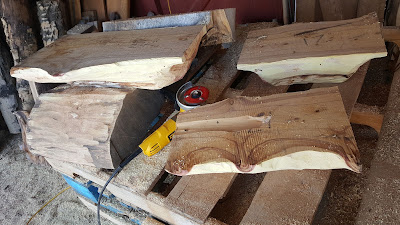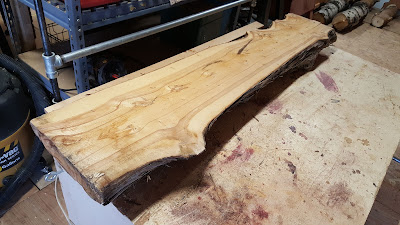I've often wondered why woodworkers who do this kind of work call carving out a bowl "hogging"? Seriously, can anyone answer that question? Anyone?
But I digress....
Today began the process of hogging out the actual bowl depth on those blanks from the previous post.
The tool used in this process is an angle grinder with a handy-dandy ArborTech Turbo Mini-Planer attached.
While this tool doesn't remove stock as fast or as aggressively as that carving disc I talked about yesterday, there's really nothing like it to be able to get down into these bowls like this tool does.
In order to hold the slab stable while carving, that work table in the photo above had to be used because the weather today didn't cooperate like it did yesterday. So, there was no outside work to be done.
Inside work is ok, but it sure does make a sawdust mess all over the shop! No dust collection system works very well either because the planer on this angle grinder tends to throw shavings (not dust) all over and in every direction. That push broom is 30 inches wide to give a little perspective.
Oh, well....just need to devote more time to clean-up at the end of the day.
The work table is basically a trough with two 4x6 inch planks placed against the outside edges of the table on the inside of those edges. That leaves an open area in the middle that most pieces fit down into. If their shape is too irregular, they can be weighted with different heavy metal pieces (axe head in the photo, for example) to hold them steady while I'm working.
After about one hour and hands going numb from vibration and tight gripping of the angle grinder, one bowl is 'hogged' out and kinda sorta shaped in preparation for fine tuning and tweaking everything:
This is why I love working with juniper. The pieces are like a box of chocolates (to coin a phrase from Forrest Gump)....you never know what the red heartwood will look like until you get down into it. I'd say these two pieces are a score!!
Taking a break to feed my face and rest up a bit for hogging out the biggest slab (looks like an aircraft carrier without the conning tower).
That one's going to take a bit longer to do because it's so much bigger than the other two.
Wish me luck!!!
BREAK'S OVER!!!!!! GET BACK TO WORK, YOU SLACKER!!!!!
Back at it....
Large bowls like this one take longer to hog out because of their size.....DUH! But, the red heartwood getting exposed is a trip in and of itself, and this bowl didn't disappoint, for sure.
I should have quit for the day at this point, but I just couldn't resist going the next step on this bigger bowl.....fine grinding and sanding. In order to do that, the turbo mini-planer had to be changed out, and a 4 1/2 inch Kutzall grinding disc/wheel put on the angle grinder.






























